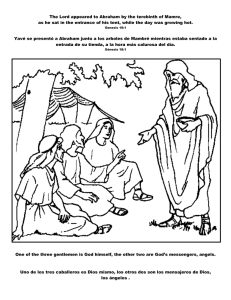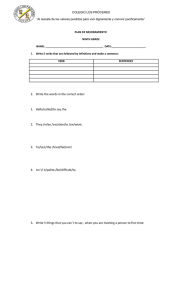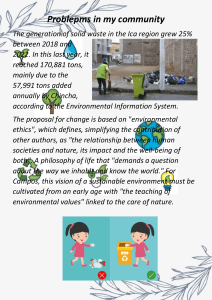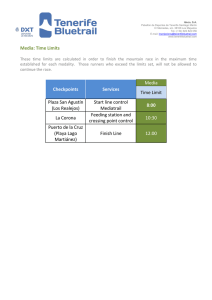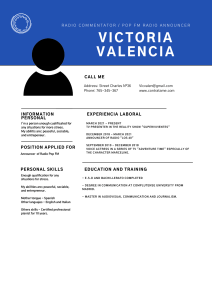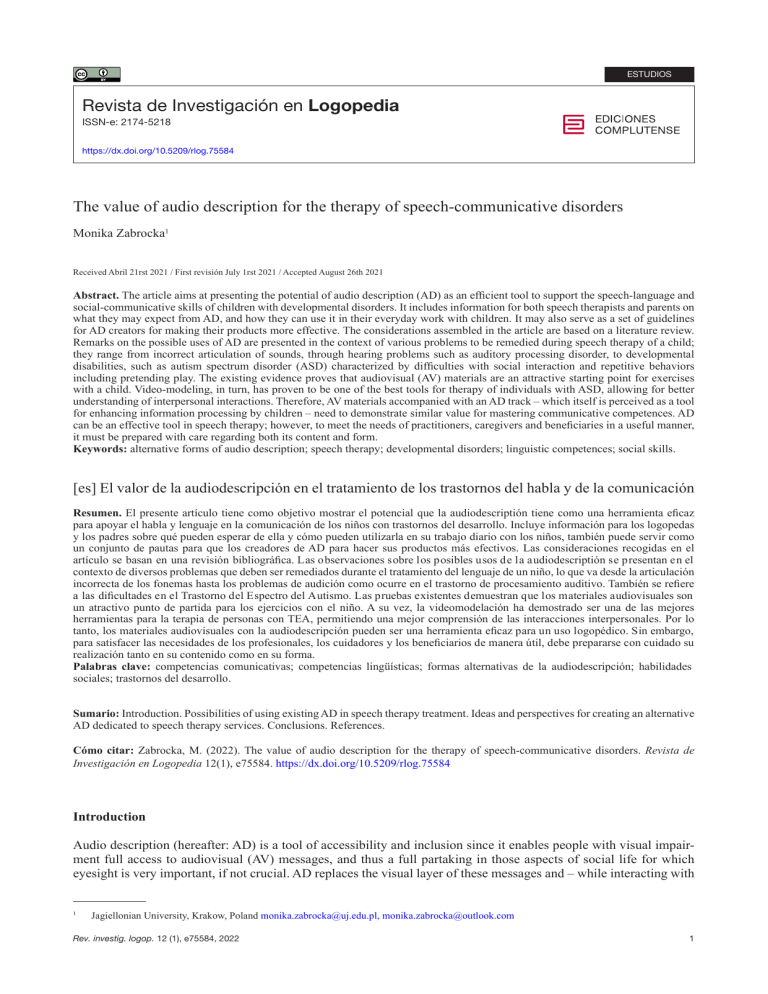
ESTUDIOS Revista de Investigación en Logopedia ISSN-e: 2174-5218 https://dx.doi.org/10.5209/rlog.75584 The value of audio description for the therapy of speech-communicative disorders Monika Zabrocka1 Received Abril 21rst 2021 / First revisión July 1rst 2021 / Accepted August 26th 2021 Abstract. The article aims at presenting the potential of audio description (AD) as an efficient tool to support the speech-language and social-communicative skills of children with developmental disorders. It includes information for both speech therapists and parents on what they may expect from AD, and how they can use it in their everyday work with children. It may also serve as a set of guidelines for AD creators for making their products more effective. The considerations assembled in the article are based on a literature review. Remarks on the possible uses of AD are presented in the context of various problems to be remedied during speech therapy of a child; they range from incorrect articulation of sounds, through hearing problems such as auditory processing disorder, to developmental disabilities, such as autism spectrum disorder (ASD) characterized by difficulties with social interaction and repetitive behaviors including pretending play. The existing evidence proves that audiovisual (AV) materials are an attractive starting point for exercises with a child. Video-modeling, in turn, has proven to be one of the best tools for therapy of individuals with ASD, allowing for better understanding of interpersonal interactions. Therefore, AV materials accompanied with an AD track – which itself is perceived as a tool for enhancing information processing by children – need to demonstrate similar value for mastering communicative competences. AD can be an effective tool in speech therapy; however, to meet the needs of practitioners, caregivers and beneficiaries in a useful manner, it must be prepared with care regarding both its content and form. Keywords: alternative forms of audio description; speech therapy; developmental disorders; linguistic competences; social skills. [es] El valor de la audiodescripción en el tratamiento de los trastornos del habla y de la comunicación Resumen. El presente artículo tiene como objetivo mostrar el potencial que la audiodescriptión tiene como una herramienta eficaz para apoyar el habla y lenguaje en la comunicación de los niños con trastornos del desarrollo. Incluye información para los logopedas y los padres sobre qué pueden esperar de ella y cómo pueden utilizarla en su trabajo diario con los niños, también puede servir como un conjunto de pautas para que los creadores de AD para hacer sus productos más efectivos. Las consideraciones recogidas en el artículo se basan en una revisión bibliográfica. Las observaciones sobre los posibles usos de la audiodescriptión se presentan en el contexto de diversos problemas que deben ser remediados durante el tratamiento del lenguaje de un niño, lo que va desde la articulación incorrecta de los fonemas hasta los problemas de audición como ocurre en el trastorno de procesamiento auditivo. También se refiere a las dificultades en el Trastorno del Espectro del Autismo. Las pruebas existentes demuestran que los materiales audiovisuales son un atractivo punto de partida para los ejercicios con el niño. A su vez, la videomodelación ha demostrado ser una de las mejores herramientas para la terapia de personas con TEA, permitiendo una mejor comprensión de las interacciones interpersonales. Por lo tanto, los materiales audiovisuales con la audiodescripción pueden ser una herramienta eficaz para un uso logopédico. Sin embargo, para satisfacer las necesidades de los profesionales, los cuidadores y los beneficiarios de manera útil, debe prepararse con cuidado su realización tanto en su contenido como en su forma. Palabras clave: competencias comunicativas; competencias lingüísticas; formas alternativas de la audiodescripción; habilidades sociales; trastornos del desarrollo. Sumario: Introduction. Possibilities of using existing AD in speech therapy treatment. Ideas and perspectives for creating an alternative AD dedicated to speech therapy services. Conclusions. References. Cómo citar: Zabrocka, M. (2022). The value of audio description for the therapy of speech-communicative disorders. Revista de Investigación en Logopedia 12(1), e75584. https://dx.doi.org/10.5209/rlog.75584 Introduction Audio description (hereafter: AD) is a tool of accessibility and inclusion since it enables people with visual impairment full access to audiovisual (AV) messages, and thus a full partaking in those aspects of social life for which eyesight is very important, if not crucial. AD replaces the visual layer of these messages and – while interacting with 1 Jagiellonian University, Krakow, Poland [email protected], [email protected] Rev. investig. logop. 12 (1), e75584, 2022 1 Zabrocka, M. Rev. investig. logop. 12 (1), e75584, 2022 2 their other layers – informs the recipient about their content. Since the oral commentary that supplements works of art such as films or theater and opera performances customarily appears in pauses between dialogues (e.g. Braun 2007; Lopez et al. 2018), it has to be concise. Moreover, AD is also useful in museums and art galleries, or during sports events and in public spaces. It can describe articles, taking the form of descriptions of graphic elements contained therein, such as tables or charts (Holsanova 2020). In its most basic assumption, AD is to respond to the needs of people who are blind or have limited vision. Their needs, however, are very different, if only for the reason of the heterogeneous nature of these groups of viewers, which include people who cannot see from birth, those who stopped seeing at different ages, people that have limited or residual vision, or only sensitivity to light. Also, the age of AD users, their knowledge and level of linguistic development have an impact on what information should be included in it so that it fulfills its function as well as possible (Zabrocka 2018). Already in the context of viewers with sight loss alone, there is a need to answer the question of whether the AD creation process should be subject to some universal guidelines and to what extent audio-describers can deviate from them as part of their artistic license to guarantee their target audience the possibility of choosing the AD narrative the most appropriate for them (Lopez et al. 2018, 2020a). Additionally, it is worth considering what AD would be interesting and useful for the audiences without visual impairment, for example, as a tool contributing to the growth of intercultural competences and supporting foreign language learning (Vermeulen & Ibáñez 2017, 2018; Vermeulen & Escobar-Álvarez 2021). This article is devoted to the perspectives of using AD beyond its primary purpose, as a tool of inclusion and support, but in the context of speech therapy understood as both speech-language and social communicative skills treatment. On the one hand, it discusses the ways of using the already existing audio-described animated films by speech therapists during their work with young patients. On the other, it shows how an alternative AD may be prepared – whether by an audio-describer creating it for the needs of, for example, TV, or by a therapist preparing a tool for work with a child – to make the most of its potential. Possibilities of using existing AD in speech therapy treatment In speech therapy, AV materials, including short animated films, can be an attractive starting point for both conversation and exercises with a child. Their importance for educational results stems – among other reasons – from the fact that they are a frequently chosen form of entertainment (Giełzak-Chudziak 2010). Children not only like watching movies and TV programs, but also recreating during their play the situations spotted on the screen. The pleasure they get from these two activities motivates them to engage in speech therapy exercises referring to AV materials. The phenomenon of positive reinforcement used in this way may be crucial for the success of the therapy (Sekułowicz & Sokołowska-Kasperiuk 2015). An AD track complementing AV materials is considered an effective teaching instrument because it provides children with information through the aural and visual layer at once. In this way, it supports information processing, as well as increases chances of their absorption by children (Krejtz I. et al. 2012; Krejtz K. et al. 2012, 2014; Peskoe – n.d.). The same factors give AD the potential to enhance the development of children’s linguistic and communicative competences (Rapin & Dunn 1997; Reuterskiöld & Zabrocka, in preparation; Zabrocka 2019, 2021a). It is worth emphasizing that the mere presence of an additional oral narration track contributes to the training of phonemic hearing, which is the ability (related to the proper functioning of hearing) to distinguish verbal stimuli (cf. p. 5). This, in turn, is the basis for the understanding of heard speech, and, as a consequence, for the development of active speech and reading and writing skills (Styczek 1982). ‘Providing’ a child with language through the aural and visual channel at the same time, thus reinforcing one’s own speech with a visual reference or – conversely – adding appropriate verbal comments to everyday activities that a child follows with their eyes, is a recommended form of speech therapy support in the case of children with diagnosed verbal auditory agnosia (Rapin & Dunn 1997). The success of further speech therapy, including the effectiveness of articulation training, depends on the proper cognitive functioning of children and the efficiency of their memory (with auditory memory foremost). AD will make it easier for children to carefully watch an animated film or TV program and focus on the elements that are vital for the proper understanding of the plot and message. It likewise helps them notice and remember many important details as well as a sequence of events. As a result, after viewing the film or TV program accompanied by a clearly written AD track, children should answer the speech therapist’s questions (such as: What did the hippo do?2; What grows next to the bear’s house?; Why couldn’t the badger play the trumpet during the forest festival?; Was the raccoon satisfied with meeting a rabbit?) more correctly and more precisely than in the case of the same AV material without the AD track (Reuterskiöld & Zabrocka, in preparation). On the basis of the already existing studies (ibid.) it can be assumed that children supported with AD will achieve better results in other memory-testing tasks, such as guessing the name of a character, object, or place on the basis of a short description provided by a speech therapist referring to the elements mentioned in the AD narration. The 2 All the examples (of both questions that the patients can be asked and phrases that may be included in AD track) provided throughout the text were created by its author as a part of an illustration. Zabrocka, M. Rev. investig. logop. 12 (1), e75584, 2022 3 presence of AD should also positively influence children’s ability to formulate such puzzles on their own. As part of the exercises, the therapist may also prepare a short commentary to the watched AV material, referring to the visual content, dialogues, and the AD track, and ask a child to indicate incorrect information. This trains not only memory, but also the ability to select information. In the speech therapy of a preschool- or early school-age child, especially with delayed speech development, specific language impairment, or aphasia, AV materials supplemented with AD can be used for memory training aimed at expanding the lexical resources. This will support children in, for example, exercises on recalling the names of the characters shown in the video, animals, vehicles, fruits or other objects, as well as determining their characteristic features (regarding their appearance, disposition, behavior or sounds made by them) and their correct categorization, such as by type (fruit, vegetables, wild/domestic animals, tools, school supplies) by their usual place (kitchen, bathroom, workshop, garden, zoo, farm). If the AD track contains words that are less frequently used, more difficult, or even ‘technical’ (such as equipment, menagerie, emblem), a speech therapist or a parent may, as part of the exercises, ask a child to repeat them or lead a conversation in such a way that the words will appear in the child’s dictionary permanently. Rich vocabulary in the children’s environment, and therefore also in AV materials to which children have access, helps them enlarge their vocabulary. Assuming that AD can support young viewers’ mental operations, one should also assume that any AV material with an AD track will make it easier for them to understand cause-and-effect sequences, and – at once – will make it easier for them to associate facts and answer questions such as: Why did the bird fall down from a tree?; Why did the frog say that it is not worth helping anyone?; or What incident made the animals to stop their trip to the city, and why? In other words, the presence of AD will positively influence the child’s ability to build more complex statements, including those about the characters’ motives and the sequence of actions taken by them for a specific purpose. Equally profitably, the presence of AD can also contribute to the coherence of children’s narrative skills. By suggesting the right words, and sometimes even whole phrases, it will help them in the tasks of telling what a watched movie or TV program was about, recalling its moral, discussing the issues raised in the plot or adding a continuation to a fragment of the watched story already retold by a therapist or a parent. Even if the phrases heard in AD will not be permanently remembered by a child, they will still work as a stimulator of the correct understanding and use of syntax and grammatical tenses. They will also result – at least at this particular moment – in successful communication, which is not without significance for psychological reasons and may motivate a child to continue working with a speech therapist during the speech intervention session or with a caregiver – at home – as part of refresher training. In a broader sense, AD can be a stimulus not only for oral motor training, but also motor skills and sensory integration (SI) exercises. By drawing children’s attention to the characters’ various activities, it encourages them to imitate – as part of play – the movements and sounds appearing in the video, for example jumping upwards (with the shout Hop!) or as when riding a horse (with smacking the tongue and shouting Yee-haw!). A child can also pretend to ski (Shoo! Shoo!), boxing (Bam! Bam!), playing instruments (Ding-ding!; Droning-thumping!; Tam-tara-tam-tara!), sweeping or scrubbing something (Shrub-shrub), looking through properly arranged hands as through binoculars or a telescope (admiring the views you see – Ah!), moving their arms like a duck’s wings (Quack-quack) or like a tree with branches, humming Shooo... (which additionally is an exhalation control exercise). To make this type of exercise more attractive, therapists or carers can use the accessories that appeared or were mentioned in the watched AV product and the AD track that complemented it, such as straws into which children blow with different force or through which they drink liquids of different densities, or feathers / little windmills on which they blow (oral praxis exercises). For the same purpose, children may be asked to eat invisible ice cream or lick their lips once it has been eaten off a stick. On this principle, a child’s cheeks can become balloons – when they take in air, the child inflates them, holds for a moment (breathing control, keeping the tongue properly in the resting position) and slowly, pressing the hands on the cheeks, relieves the ‘balloons’ of their air (control of exhalation). As part of SI training (and at the same time for memory training), one can cover children’s eyes and ask them to look for various items in a box, the names of which should be remembered from the AV material watched and the accompanying AD track (e.g. a pine cone, a pebble, a ball of wool, a feather, a piece of fur, a stick). Ideas and perspectives for creating an alternative AD dedicated to speech therapy services Although the tendencies in this matter are changing (Lopez et al. 2020a), AD is still most often defined as a neutral, objective description, which means that it is recommended to avoid interpretative or explanatory comments in it. At the same time, research on Polish AD for children indicated that some of its authors recognize young viewers as special viewers, and AD created for them as special enough to employ various stylistic figures, such as onomatopoeias, exclamations or rhetorical questions, which they would rather avoid in AD for adults (Zabrocka 2018). The use of these means of expression may contribute to increasing children’s involvement in the reception of both the AD itself and the film or program it accompanies, as well as in stimulating the process of remembering the information provided. It is related to so-called arousal theory, according to which people better absorb the content in which they are emotionally involved, because this type of stimulation improves human cognitive processes (Mayer 2009; Zabrocka 2021a). Moreover, the emotional character of the linguistic material used in intervention for the stimulation 4 Zabrocka, M. Rev. investig. logop. 12 (1), e75584, 2022 of patients with aphasia (related to, for example, its adaptation to their interests and communication needs) positively influences its understanding by these people and is the basis for effective therapy (Panasiuk 2015; Reuterskiöld 1991; Zabrocka 2021a). The exclamations, especially those of an onomatopoeic character, will perfectly suit AD track for younger children who are in the initial stages of speech development (the period of melody and expression). Introduced into AD, they will attract a child’s attention and make her/him play with repeating them. Imitating sounds or noises is an important element of a child’s speech development. The exclamations may take the form of individual sounds, which, however, should have some meaning (purposefulness is a very important factor motivating children to master their speech), or syllables, or entire sequences of syllables forming an attractive, simple, and clear message. In such an alternative AD, the use of exclamations as in the following examples will work well: Ah! There goes the frog; Mr. Hedgehog waters the flowers on the flowerbed: drip, drip, drip!; Oh my! A butterfly sat on the girl’s nose!; It fell straight into the bushes. Boom!’; Parents eat ice cream with spoons. Yum-yum!; Pheeew! What a relief!; Grrr! The dog is angry. Woof-woof! It scares off the newcomer; The frog jumps into a puddle. Splash!; The moose dives in the pond. Pom, pom!; Oh no! Someone’s walking in the orchard; Vroom, vroom! A tractor is coming; The fire brigade is running their siren: nee-naw, nee-naw!; Tiger is cold – Brrr!; Bunny – hip, hip, hop! – leaves the room hastily; A cow makes ‘moo’! A goat makes ‘mee’?; Little girl jumps joyfully – Hop, hop! Bouncy, bouncy, hop! – and sings: La, la, la...; A fox puts her brother to sleep. Lully, lullay... In the last two examples, it is also worth paying attention to the ‘l’ appearing in the onset of the syllables, the repetition of which – due to the arrangement of the speech articles – is helpful in the work on the verticalization of the tongue. In turn, roar, vroom-vroom or purr-purr will practice the articulation of the ‘r’ sound in different positions in a word. Likewise, exclamations and onomatopoeias that contain sounds difficult to pronounce can be accumulated in AD. To stimulate a child’s attention, comprehension questions can be included in AD: (Someone is walking in the orchard. Who is it?; There is a small, grey fluffy animal on the truck trailer. Do you know its name?), questions with answers (Who ate all the candies? The kids!; You don’t know what a steamer is, do you? It’s a steam-powered vessel.) or commentaries (He browses a book, so he flies through it – page after page – very quickly as if he was looking for something; The elephant is big and grey. It has large ears and a long trunk and uses it to breathe and smell – like a nose! – and to wash itself as if it was taking a shower; A lion is a big cat, it is a cat’s cousin. It has a lush mane and is very fast!). Questions based on associations or which refer to things well known to children will appeal to young viewer’s imagination particularly effectively, have a chance to be remembered best by them and enrich their knowledge and vocabulary. In children diagnosed with developmental disorders, such as Down syndrome (DS), autism spectrum disorders (ASD), aphasia or schizophrenia, difficulties with understanding non-literal utterances such as proverbs, phraseologies, metaphors, allusions, and jokes are very typical. AD may be helpful with explanations such as: the boy plunges under the quilt, or jumps into bed and covers himself with the quilt up to the top of his head; the ducks went there single file – that is, one after the other; kitty smiles from ear to ear – that is, she smiles broadly; or the teacher says that Johnny is bad news, which means that he is a rascal and a troublemaker. Usually burdensome for this group of children are terms comparing two people or objects (a mouse is smaller than a rat, so a rat is larger than a mouse) and prepositions such as under, over, before, after. For this reason, it will be helpful to skillfully integrate them into the text of AD and place them in a clear visual context. The descriptions-explanations constructed in such a way will also be beneficial for children in the development norm. By referring to AD, we can not only introduce new or difficult words in terms of meaning into the child’s dictionary (see p. 3), but also, for example, practice pronunciation of words that are difficult in terms of articulation. The accumulation of words with troubling sounds in AD creates an opportunity for the therapist to practice them with the child, for example, by highlighting the words or sounds that appeared in AD in the indicated context, repeating them, and by asking the child questions related to these sounds or words. The latter exercise obliges the child to use them in the context of a sentence, which is particularly important as developing the correct pronunciation of a sound in a single word is not synonymous with its correct articulation in a sequence of words. AD is perfect for training social skills, which is also very useful in the therapy of children, including those with ASD, characterized by reduced situational efficiency and manifested by difficulties in building narrative statements in various communication situations (Grabias 1994; Lipski 2015). This is related to the lack of interest in social stimuli or even the ignoring of them, and – as a consequence – difficulties in observing and reproducing typical interactions by initiating and sustaining them (Markiewicz 2015; Michalik 2018; Pisula 2012). Due to the fact that people with ASD (especially those who are intellectually highly functional) collect information about the world most effectively through visual stimuli, it is very helpful to use appropriate AV materials during their therapy (Rapin & Dunn 1997; Markiewicz 2015). For this reason, video modeling – showing recordings of typical interactions and then discussing them with a child – is considered very effective (Bellini & Akullian 2007; Sekułowicz & Sokołowska-Kasperiuk 2015; Sokołowska 2017). The effectiveness of this method, apparent in the acquisition of specific skills by children with ASD several times faster than during in vivo sessions, is related to the fact that video modeling helps them focus on specific elements captured in the camera lens (Maich & Hall 2016). We will achieve a similar effect by using AD that emphasizes the relevant aspect of the visual layer of a film or program, by emphasizing the presented communication situations, commenting on them and – when necessary and Zabrocka, M. Rev. investig. logop. 12 (1), e75584, 2022 5 possible – explaining them. The AD track may inform one about behaviors which are socially acceptable, and which are not, and why. It may also explain the relationships between characters (pig is the mother of piglet, piglet is the son of pig; for Julie, John is an uncle, Julie is John’s niece), the understanding of which may pose some problems to children. AD emphasizing interactions and social relations will facilitate a play in which a therapist or a parent and the child – perhaps using mascots or puppets – jumps into the shoes of characters and recreates the situations presented in the AV material. In this way, children practice symbolic play, which is the basis and one of the first manifestations of the theory of mind’s development and which is something incomprehensible for children with ASD (Winczura 2015). They also learn how to build dialogues in situations such as saying hello or goodbye, apologizing, inviting, shopping in a store, or visiting a doctor, including emotional tuning appropriate to the situation (intonation, gestures), which is often not implemented correctly by children with developmental disorders such as ASD or DS. Reactions inadequate to contexts, hindering the adaptation of these children in a social group, are the result of an incorrect model of functioning in communicative situations resulting from problems with understanding their own emotions and other people’s emotions. These problems, as well as the difficulties in social interactions themselves, are closely related to disturbances in the development of the theory of mind (Winczura 2015). Therefore, from the point of view of psycho-emotional and linguistic-communicative development of the child, AD is very beneficial, while it helps one to understand the emotions of the characters (Reuterskiöld & Zabrocka, in preparation) by paying attention to them or even explaining them. For example: Emily has a sad face, twists her face into a horseshoe. Is she sorry that Emma said that?; Mary cries because of fear; Yes! Teddy nods for consent; No! Antoine shakes his head!; Luisa is happy – she jumps and smiles broadly; Johnny is surprised. Ooo!; or Leon kisses his son – smack! After the screening of AV material with AD, a child can be asked to enumerate positive and negative emotions that were presented there (short-term memory training, segmentation of elements) and indicate the situations these emotions are related within the film and in real life (reference to the child’s experience). Questions like How did the puppy feel when he was thrown out by the children? or What would you say to console the puppy? are aimed at training children’s memory and helping them master the understanding of inferences, cause-effect relationships and formulating hypotheses about the beliefs, intentions, and emotional states of other people in specific situations. They also help children to understand that, depending on the point of view, the same situation may evoke different feelings or reactions in different people. A very effective technique in the development of disturbed theory of mind in children with ASD is video modeling. In the same way, and for the same reasons, efficient may be an AD that draws attention to the characters’ emotions, especially those expressed through facial expressions and eye contact, which ASD children often do not notice and whose meanings cannot be correctly decoded by them (Belter-Czerniak 2012; Winczura 2015). In addition, it is an excellent starting point for a play based on reflecting the facial expressions of the emotional states of the characters from the video watched in order to exercise the tongue and facial muscles, especially the circular muscle of the lips. As already mentioned, AD can upskill speech hearing consisting of phonetic and phonemic hearing (cf. p. 2). It will also prove useful in the treatment of patients with delays in the development of auditory perception. These – unless they result from physiological hearing loss – do not require medical intervention, and their development can be supported by simple exercises of recognizing, differentiating and determining the source of sounds performed under the supervision of a speech therapist or a caregiver. After screening the AV material with AD consisting not only of narration, but also of appropriate sound effects, a therapist or a caregiver can ask a child to list as many of them as possible, or to indicate characters and objects which appeared on the screen and with which these sounds are connected. Children may also react with a specific movement each time they hear a predetermined word or sound effect or signal in the AD track. These stimuli must appear at least on several occasions in one AD track; in time, it is also possible to introduce more and more of them to this sort of exercises as well as diversify the movements that the children are asked to perform (squat or turn, jump, wave, clap, hit the drum, shake the game, etc.), in order to stimulate their motor skills. Reception by various groups of viewers of AD in which sound effects and audio spatialization is employed to supplement (and sometimes even replace) a verbal description and to create a fully accessible work (such as a film) is still a subject of research. However, the up-to-date evidence we have at our disposal proves this technique of audio-describing to be as well received by recipients as the traditional ones (Lopez et al. 2018, 2020b). Similarly, respondents taking part in the tests have equally favorable impressions towards first-person AD, which, for example, may help children to better understand the emotional states of others (Lopez et al. 2020a). In addition, all auditory perception exercises, especially those which aim to determine the type and source of sound, are also perfect for compensatory education of children who are blind, e.g. spatial orientation training. Finally, it is worth mentioning the possibility of creating an alternative AD, which would be based on comparisons of the characters’ movements to the position of the articulation organs. For example: The bear sits hidden, like a tongue behind his teeth; A squirrel counts nuts, like a tongue counts teeth (at the same time the child can count on their fingers, practicing motor coordination); Mr. Wolf presses the bell as the tongue presses the palate; The grass snake rises up, as the tongue rises to the palate; The sun appeared in the sky – it’s round like our lips when we say ‘Oooh!’. These types of comments will be particularly applicable in materials prepared for speech therapy as they are intended to encourage children to exercise their tongue and lips and to consolidate correct habits as regards the posi- 6 Zabrocka, M. Rev. investig. logop. 12 (1), e75584, 2022 tion of the articulation organs. In the case of children with sight loss such AD has an additional advantage – evocative comparisons make it easier for them to imagine the movements of the described character. Conclusions This article discusses the possibilities of creating an alternative AD, thanks to which it can become something more than just a oral narration track complementing AV materials used in a child’s speech therapy. So, it can itself be an instrument stimulating child’s linguistic and communicative development. As such, AD would no longer be a product created solely to support people with visual impairment but becomes a tool of inclusion in a broader sense. AD is subject to various constraints, mainly related to the very short time between dialogues, in which the audio-describer must include a fitting portrayal of what is included in the visual layer of the described product. This article indicates the elements the presence of which would give AD additional educational and therapeutic value. It can be an inspiration not only for audio-describers who could create AD of a wider social application (e.g.in compensatory education or speech therapy), but also for speech therapists wanting to supplement their own AV materials with AD tracks adapted to the individual needs of each patient. Certainly, an AD used in speech therapy must be sufficiently simple, so that the information it contains would be easy for a child to understand and to memorize. One should also remember change into: to repeat the words or sounds that a child is expected to learn, as well as to include the appropriate intonation. A bit of acting, which is not necessarily desirable in the case of AD for adults, but which will complement AD with information that could not be included in words and will make it easier for children to read the meaning, may be particularly important stimulation in speech therapy patients. Of course, in the case of children who have not reached certain milestones of their language development or have a speech impediment, AD will not replace properly programmed speech therapy. However, it can still stimulate their linguistic and communication skills and serve as an additional stimulus, at the same time diversifying the tasks performed with the therapist or parents – especially when the latter use materials prepared and recommended by a specialist. This article is a complementary version of the Polish article published in a journal dedicated to speech therapists – practitioners (2021b in references). References Bellini, S., Akullian, J. (2007) A meta-analysis of video modeling and video self-modeling interventions for children and adolescents with ASD. Exceptional children, 73, 261-284. Belter-Czerniak, J. (2012) Autyzm dziecięcy w diagnozie i terapii neurologopedycznej [Child autism in a neurologopedist’s diagnosis and therapy]. Neurologopedia w teorii i praktyce [Neurologopedic in theory and practice], J. Skibka & D. Larysz (eds.), Bielsko-Biała: Wydawnictwo Naukowe Akademii Techniczno-Humanistycznej, 177-213. Braun, S. (2007) Audio description from a discourse perspective: a socially relevant framework for research and training. Linguistica Antverpiensia, 6, 357-369. Giełzak-Chudziak, M. (2010). Miejsce środków masowego przekazu w czasie wolnym dzieci [The place of mass media in children’s leisure time]. Edukacja, wychowanie, poradnictwo w mediach [Education, upbringing, guidance in the media], M. Wawrzyniak-Chodaczek, A. Łysak & M. Kondracka-Szala (eds.), Toruń: Wydawnictwo Adam Marszałek, 38–57. Grabias, S. (1994) Język w nauczaniu niesłyszących. Zasady programowania systemu komunikacyjnego [Language in teaching Deaf individuals. Principles of communication system programming]. Komunikacja językowa i jej zaburzenia, tom 7 – Głuchota a język [Language communication and its disorders, vol. 7 – Deafness and language], S. Grabias (ed.), 185-221. Holsanova, J. (2020) Uncovering scientific and multimodal literacy through audio description. Journal of visual literacy, DOI: 10.1080/1051144X.2020.1826219. Krejtz, I., Szarkowska, A., Krejtz, K., Walczak, A., Duchowski, A. (2012) Audio description as an aural guide of children’s visual attention: Evidence from an eye-tracking study. ETRA’12 Proceedings of the Symposium on eye tracking research and applications, 99-106. Krejtz, K., Krejtz, I., Duchowski, A., Szarkowska, A., Walczak, A. (2012) Multimodal learning with audio description: An eye tracking study of children’s gaze during a visual recognition task. Proceedings of the ACM Symposium on applied perception (SAP ’12), 83-90. Krejtz, K., Krejtz, I., Szarkowska, A., Kopacz, A. (2014) Multimedia w edukacji. Potencjał audiodeskrypcji w kierowaniu uwagą wzrokową dziecka [Multimedia in education: AD potential in guiding the learner’s visual attention]. Przekładaniec. A Journal Of Translation Studies, 28, 80-92. Lipski, W. (2015) Standard postępowania logopedycznego w przypadku autyzmu [Standard of speech therapy in autism]. Logopedia. Standardy postepowania logopedycznego [Speech therapy. Standards in speech therapy intervention], S. Grabias, J. Panasiuk & T. Woźniak (eds.), Lublin: Wydawnictwo UMCS, 461-516. Lopez, M., Kearney, G., Hofstädter, K. (2018) Audio Description in the UK: What works, what doesn’t, and understanding the need for personalising access. British journal of visual impairment, 36 (3), 274-291, DOI: 10.1177/0264619618794750. Lopez, M., Kearney, G., Hofstädter, K. (2020a) Seeing films through sound: Sound design, spatial audio, and accessibility for visually impaired audiences. British Journal Of Visual Impairment, 1-28, DOI: 10.1177/0264619620935935. Zabrocka, M. Rev. investig. logop. 12 (1), e75584, 2022 7 Lopez, M., Kearney, G., Hofstädter, K., Balla, G. (2020b) Enhancing audio description: accessible filmmaking, sound design and the importance of educating filmmakers. Media Practice and Education, 21, 289-304. Maich, K., Hall, C. (2016) Autism Spectrum Disorder in the Ontario Context: An Introduction. Toronto: Canadian Scholars’ Press. Markiewicz, K. (2015) Kompetencje i dysfunkcje komunikacyjne osób z ASD – ujęcie rozwojowe [Communicative competences and dysfunctions of people with ASD – a developmental approach]. Autyzm i AAC. Alternatywne i wspomagające sposoby porozumiewania się w edukacji osób z autyzmem [Autism and AAC. Alternative and supportive methods of communication in education of individuals with autism], B. B. Kaczmarek & A. Wojciechowska (eds.), Kraków: Impuls, 17-32. Mayer, R. E. (2009) Multimedia learning (2nd ed.), New York: Cambridge University Press Inc. Michalik, M. (2018) Lingwistyczno-logopedyczne podstawy komunikacji alternatywnej i wspomagającej: ujęcie metodologiczne [Linguistic and speech therapy basics of alternative and supportive communication: methodological approach], Kraków: Wydawnictwo Uniwersytetu Pedagogicznego. Panasiuk, J. (2015) Postępowanie logopedyczne w przypadku alalii i niedokształcenia mowy o typie afazji [Speech therapy in the case of alalia and aphasia-type speech underdevelopment]. Logopedia. Standardy postepowania logopedycznego [Speech therapy. Standards in speech therapy intervention], S. Grabias, J. Panasiuk & T. Woźniak (eds.), Lublin: Wydawnictwo UMCS, 309-345. Peskoe, M. (n.d.). Descriptive children’s television: Bridging the gap for blind kids while benefiting all kids. Last accessed on the 6th January 2021 on: https://dcmp.org/learn/static-assets/nadh237.pdf. Pisula, E. (2012) Autyzm. Przyczyny, symptomy, terapia [Autism. Reasons, symptoms, therapy], Gdańsk: Wydawnictwo Harmonia. Rapin, I., Dunn, M. (1997) Language disorders in children with autism. Seminars in Pediatric Neurology, 4 (2), 86-92. Reuterskiöld, C. (1991) The effects of emotionality on auditory comprehension in aphasia. Cortex, 27 (4), 595-604. Reuterskiöld, C., Zabrocka, M. (in preparation) Report on a pilot study on the audio description’s impact on the emotions processing by individuals with Down syndrome. Sekułowicz, M., Sokołowska-Kasperiuk, A. (2015) Video modeling jako alternatywna metoda usprawniania komunikacji społecznej dzieci z autystycznego spektrum zaburzeń [Video modeling as an alternative method of improving social communication of children from the autistic spectrum of disorders]. Autyzm i AAC. Alternatywne i wspomagające sposoby porozumiewania się w edukacji osób z autyzmem [Autism and AAC. Alternative and supportive methods of communication in education of individuals with autism], B. B. Kaczmarek & A. Wojciechowska (eds.), Kraków: Impuls, 269-292. Sokołowska, A. (2017) Video modeling jako innowacyjna technika pracy terapeutyczno-edukacyjnej z dziećmi z zaburzeniami ze spektrum autyzmu [Video modeling as an innovative technique of therapeutic and educational work with children with autism spectrum disorders]. Prace naukowe Wyższej Szkoły Zarządzania i przedsiębiorczości z siedzibą w Wałbrzychu, tom 44 – Zeszyty pedagogiczno-medyczne [Scientific work of the College of Management and Entrepreneurship with headquarters in Wałbrzych, vol. 44 – Pedagogical and medical notebooks], M. J. Żmichrowska (ed.), 115-138. Styczek, I. (1982) Badania i kształcenie słuchu fonetycznego [Research and training of phonetic hearing], Warszawa: Wydawnictwo Szkolne i Pedagogiczne. Vermeulen, A., Ibáñez Moreno, A. (2017) Audio description as a tool to enhance intercultural competence. Transcultural competence in translation pedagogy, J. Deconinck, P. Humblé, A. Sepp & H. Stengers (eds.), 133-156. Vermeulen, A., Ibáñez Moreno, A. (2018) Audio description for all: a literature review of its pedagogical values in foreign language teaching and learning. Encuentro – revista de investigacion e innovacion en la clase de idiomas (26), C. Calle Martínez (ed.), Madrid: Universidad Complutense de Madrid, 52–68. Vermeulen, A., Escobar-Alvarez, M. A. (2021) Audiovisual translation (dubbing and audio description) as a didactic tool to promote foreign language learning: the case of Spanish clitic pronouns. Translation and translanguaging in multilingual contexts, 7 (1), 86-105. Winczura, B. (2015) Komunikacja społeczna u dzieci ze spektrum autyzmu w świetle prekursorów rozwoju teorii umysłu [Social communication in children with autism spectrum disorders in the light of the precursors of the development of the theory of mind]. Autyzm i AAC. Alternatywne i wspomagające sposoby porozumiewania się w edukacji osób z autyzmem [Autism and AAC. Alternative and supportive methods of communication in education of individuals with autism], B. B. Kaczmarek & A. Wojciechowska (eds.), Kraków: Impuls, 43-68. Zabrocka, M. (2018) Efficacy of audio description dedicated to children within the functionalist approach to translation [unpublished PhD thesis submitted at the Pedagogical University of Krakow]. Zabrocka, M. (2019) Speaking metaphor in audio description for children. Culture, Language and Representation, 22, 153-169. Last accessed on the 6th January 2021 on: https://www.e-revistes.uji.es/index.php/clr/article/view/3957/3313. Zabrocka, M. (2021a) Audio description accompanying video content as a compensatory tool in socialization and cognitivelinguistic development of children with visual impairment: the search for theory for alternative AD application. The Educational and Developmental Psychologist. DOI: 10.1080/20590776.2021.1899750. Zabrocka, M. (2021b) Audiodeskrypcja – narzędzie w terapii logopedycznej? [Audio description – a tool in speech therapy?]. Forum Logopedy [Speech therapist forum], 42, 55-61.
